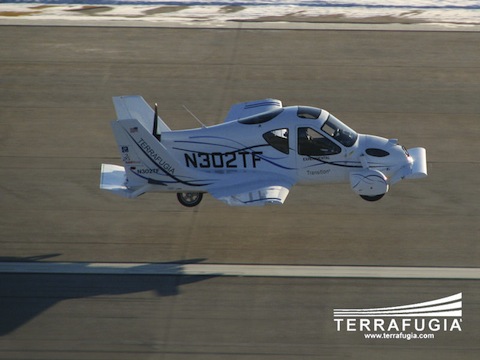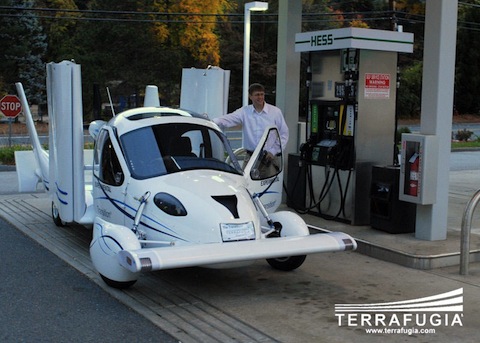
I received this from Dassault Systemes today and found that alongside having some very interesting details on the development of a new form of vehicle, it also shows an shift and two odd details – but first the details: Terrafugia, creators of the Transition Roadable Aircraft has chosen Catia for 3D composite and finite-element modeling and will be using Catia Analysis (PDF link) and Catia Composites Design (CPD) to design and develop its beta prototype, with delivery expected in 2011. The vehicle which can cruise up to 450 miles at 115+ mph, take off and land at local airports, drive at highway speeds on any road and fit in a normal suburban garage space. The two-seat vehicle has front wheel drive on the road and a propeller for flight, transforming from plane to car in thirty seconds. Both modes are powered by unleaded automobile gasoline. By giving pilots a convenient ground transportation option, the Transition reduces the cost, inconvenience and weather sensitivity of personal aviation.

After Terrafugia completed a successful Proof of Concept for the first version of its Transition Roadable Aircraft in early June, the design team began planning the vehicle’s second iteration. Having spent several years developing the initial Transition prototype, Terrafugia identified multiple ways in which they wanted to adjust the original design, including experimenting with alternate materials and sizing for the wings. In order to analyze the way different materials would bend or move under various conditions, the company required a solution with advanced 3D composite ply-modeling, dedicated part-modeling and material behavior simulation capabilities.
Now, here’s where the press release gets weird. It states that “RAND North America, a value-added reseller of Dassault Systemes PLM solutions… recommended that Terrafugia adopt Catia for its composite modeling needs. RAND chose Catia’s composite solutions for their exacting technical features, which would help Terrafugia correct problems like wrinkles and bridges in the very first stages of design by visualizing ply characteristics and fiber behavior. They also emphasized Catia’s value as an independent finite-element analysis (FEA) tool, thereby eliminating the need for a separate FEA investment.” Now. Is it me, or is odd to have a press release stating that a reseller chose the solutions for Terrafugia? Of course they did. That’s what they do and the fact that they chose the Catia-based solutions makes complete sense too. They were hardly going to sell them products from another company were they? It seems an entirely odd thing to have in a press release.
Now. Back to the details. Many of you might remember that Terrafugia appeared at SolidWorks World last year. Yes. They’re SolidWorks users. As the press release states “Impressed by its success with Dassault Systemes’ SolidWorks 3D design suite, which it began using in March 2009, Terrafugia enthusiastically adopted Catia Analysis and Catia CPD as composite-focused complements to its existing SolidWorks infrastructure.”
According to Ben Zelnick, engineer at Terrafugia: “Catia is a great complement to our SolidWorks solution. Being able to have a full digital model of a ply-by-ply layout will allow us to conduct accurate structural analyses, which is invaluable in reducing the weight of the Transition. In fact, we recently correlated an analysis of a Catia model of a portion of the structure closely to a sample tested in our facility.”
Now, this is a shift. This is the first time I can recall a Dassault press release telling the world that a customer is using SolidWorks alongside Catia. Yes, SolidWorks is the workhorse design tool, with Catia providing highly specialised design and simulation tools that simply aren’t available within the SolidWorks product stack. Of course, in a round about way, it also raises the question of SolidWorks/Catia interoperability. Catia has, for sometime, been able to read SolidWorks files natively and this is used to great effect here. Of course, passing data back from Catia to SolidWorks natively is not possible but in this instance, wouldn’t really need to happen. An interesting user story and one that shows a shift in the relationship perhaps between SolidWorks and the Dassault mothership. From talking to a lot of people from both sides of the company, there’s greater co-operation between the two than has ever been the case before and this is perhaps an indication of that and it should benefit both user communities – of course, once bi-directionality is added to move data from Catia to SolidWorks, rather than the other way around.






